
Agile Methodology, Customer Experience, Nearshore, Project Management, Successful Outsourcing
Do you have experience with outsourcing software development through an offshore vendor? What were some of the problems you faced? What problems did you recognize? What problems were glossed over in the final analysis that contributed to less than optimal results? What are your major concerns in offshore outsourcing?
It is no secret that offshore software development is a challenge beyond the usual issues in almost any IT project. Certainly there are successful projects – but what issues do businesses face when starting offshore development projects? Let’s break them down into five major areas:
1. Best Case Situations for Offshore Projects
Is your project a strong candidate for an outsourced, offshore engagement? Consider a few factors that can make or break the project from the start:
- Do you have good experience with the offshore outsourcing, the vendor, the size and type of project you are considering? Does your team? If the answer to any of these questions is not a clear, «Yes!» – you are facing an uphill battle.
- Is your internal goal for the project clear and well-understood across your organization? Is it well-accepted? In most cases, outsourced projects have several drivers, but they must be clear and rational in the current situation to be accepted. Common drivers for outsourcing are cost savings, access to resources and skills, and improved time-to-market because the project is expected to overcome some internal barriers to getting the project completed within constraints.
- Does your project fit well in situations where communication may be limited and operations (within the outsourced team) may be different than your own? In other words, can you describe your project in these terms?
- Application requirements are straight-forward, well-described and STABLE (like a rock!). No changes are contemplated.
- Application is not complex and technology required is not new or debatable. In total, the project is not groundbreaking
- Functionality is documented and well-described in a user context.
- Application is not large. It can be broken down into several, small, independent modules.
- Project is not mission-critical or considered to be risky based on projected cost and time.
Of course, covering all these issues would make any outsourced project more successful, but it would also make them a bit of a unicorn in the world of IT. In the final analysis, very few (if any) projects have stable requirements throughout their development cycle. As functionality is developed, it is natural to look deeper and consider outcomes in a different light. But, if your project is one of those golden unicorns – then even your first offshore project has a decent chance of success. If your project doesn’t fit into a best case scenario for offshore, you need to be aware that mitigations for shortcomings have costs and may drive you into corners that are difficult to escape.
2. Failure to Disconnect People and Problems
 This issue is a problem across outsourcing but of particular importance in offshore relationships. When problems are perceived during a project, they are most often traced back to an individual or team, not the processes or operational procedures in place that created the environment where the problem happened. Instead of examining the situation, organizational norms, processes and methods (and their implementations), we have a strong tendency to look for a scapegoat, a person that is at fault. This leads to a loss of trust within the team as a whole and enforcement of hierarchical control – exactly the opposite of what we need if we depend on a strong, agile team to function properly. Increased hierarchy means less direct communication with developers and conversely, less independent thought from people whose skills as «knowledge workers» makes them valuable. In an offshore situation, this can be fatal to project outcomes if there is not full-time, offshore and onshore coordination and management – which of course – raises costs and lowers productivity. And because once we have targeted an individual rather than other factors, we are very likely find ourselves repeating the same problems over and over, in slightly different configurations.
This issue is a problem across outsourcing but of particular importance in offshore relationships. When problems are perceived during a project, they are most often traced back to an individual or team, not the processes or operational procedures in place that created the environment where the problem happened. Instead of examining the situation, organizational norms, processes and methods (and their implementations), we have a strong tendency to look for a scapegoat, a person that is at fault. This leads to a loss of trust within the team as a whole and enforcement of hierarchical control – exactly the opposite of what we need if we depend on a strong, agile team to function properly. Increased hierarchy means less direct communication with developers and conversely, less independent thought from people whose skills as «knowledge workers» makes them valuable. In an offshore situation, this can be fatal to project outcomes if there is not full-time, offshore and onshore coordination and management – which of course – raises costs and lowers productivity. And because once we have targeted an individual rather than other factors, we are very likely find ourselves repeating the same problems over and over, in slightly different configurations.
3. Travel & Communications

Of course, the reason that travel and communication issues are strongly linked is that – in outsourcing you travel to facilitate better communication. Regardless of all the advances of technology, face-to-face communication is still the richest, most efficient form of communication in the design, development and production of custom software. If you want to achieve trust, a shared understanding of a product, a clear picture of your entire team (outsourced and inhouse as one), there is no better way to do it than getting everyone together in one place. Barring that – you can also achieve a lot by getting key resources together to kick off a project but there is still a deficit in communication across the team that only direct contact can overcome quickly. In addition, the experience of direct contact also holds longer within the team – enabling true collaboration across the project lifecycle.
But if hourly labor costs are considered to be part of the project drivers, the reality is that the best prices for labor on an hourly basis are likely to be in fairly distant, even remote locations. This means that travel by key personnel to or from the outsourced vendor home area is likely to occur over a longer period and many «hops.» Although the key outsourcing centers in India are not remote by today’s standards of global business, they are a considerable commitment in time and cost. You might think you can get by with inexpensive flights, accommodations and simple food – but after several days of low budget travel you are likely to find you are not at your peak in critical business meetings. The same will be true for teams coming to you from a distant location. In that case, it is more than a few amenities that can get in the way. Visas, entry processes, unfamiliarity with local customs and expectations can all become barriers to having a productive few days after a long trip.
In projects with some uncertainty, this issue of time and cost can delay travel that would be beneficial to communication until a situation becomes critical. Travel avoidance creates situations where meetings that should be cordial, collaborative discussions become frustrating negotiations that are more likely to be «lose-lose» than «win-win.»
But let’s say your project is fairly straight-forward and although there is some uncertainty, you have enough cash to allow for more than one trip with your key resources at a minimum. What other areas in communication do you have to consider in offshore situations?
 Language – Although English is certainly the language of business around the world, it isn’t everyone’s native language and although many people can read English, not everyone can write and discuss ideas verbally with the same proficiency. In addition, culture and local contexts are part of understanding each other, no matter what language is spoken. A common spoken word in one location may have no direct counterpart in another location. My «door jamb» is funny if you understand what you hear as «jam» only makes sense as a form of marmalade. If a member of your team has very little conversational experience in English, it is likely they just won’t speak in meetings because they are afraid they might say the wrong thing and they can’t follow the conversation completely. As these barriers rise, so do the work-arounds. A facilitator or go-between is added to «ensure clear communication» but in the process of clarifying they also over-simplify and leave out critical details. A translation point is added so each side doesn’t have to deal with complex issues in a language they are not familiar with but because the translator isn’t a technical or business expert, many nuances are lost in translation.
Language – Although English is certainly the language of business around the world, it isn’t everyone’s native language and although many people can read English, not everyone can write and discuss ideas verbally with the same proficiency. In addition, culture and local contexts are part of understanding each other, no matter what language is spoken. A common spoken word in one location may have no direct counterpart in another location. My «door jamb» is funny if you understand what you hear as «jam» only makes sense as a form of marmalade. If a member of your team has very little conversational experience in English, it is likely they just won’t speak in meetings because they are afraid they might say the wrong thing and they can’t follow the conversation completely. As these barriers rise, so do the work-arounds. A facilitator or go-between is added to «ensure clear communication» but in the process of clarifying they also over-simplify and leave out critical details. A translation point is added so each side doesn’t have to deal with complex issues in a language they are not familiar with but because the translator isn’t a technical or business expert, many nuances are lost in translation.
 Time Differences – In offshore situations, the working day time difference between teams can mean that there is no overlap or that there is only one or two hours in a day when some direct contact can be made. Even when accommodations are made, it is generally done by putting one or two people in the combined team at a disadvantage. If the product owner makes themselves the key point of contact, they will have to find time to accommodate the outsourced team and their local team members which can result in some very odd and frustrating hours. If a local technical manager and a distant technical manager are implemented (as is often the case), communication fidelity is lost because the production team and the product owner are not in direct communication most of the time. There are many variations of workarounds for time differences, but for software development projects, this can be a very significant issue and barrier to good project communication.
Time Differences – In offshore situations, the working day time difference between teams can mean that there is no overlap or that there is only one or two hours in a day when some direct contact can be made. Even when accommodations are made, it is generally done by putting one or two people in the combined team at a disadvantage. If the product owner makes themselves the key point of contact, they will have to find time to accommodate the outsourced team and their local team members which can result in some very odd and frustrating hours. If a local technical manager and a distant technical manager are implemented (as is often the case), communication fidelity is lost because the production team and the product owner are not in direct communication most of the time. There are many variations of workarounds for time differences, but for software development projects, this can be a very significant issue and barrier to good project communication.- Us Versus Them – In any situation with two teams in different locations, there is always a barrier to getting the team to think as one unit with shared goals and responsibilities. In offshore situations, the teams face significant barriers of culture, language, vendor-to-client relationships, and time differences together. If things go wrong at some point, the tendency to blame and in many cultures, accept blame without question, can deepen the divide between teams. Trust, the ability to speak openly and discuss issues without fear is a serious problem in offshore teams on projects with shifting requirements and critical outcomes.
- Business Domain Sharing – Every successful business has internal, proprietary knowledge is part of their key business advantage. Sharing that knowledge openly; answering questions with proper context and depth takes time, though, and trust. In outsourcing, particularly in offshore situations, sharing proprietary knowledge can be very difficult. Legal concerns, technical business language, access to subject matter experts (SMEs) in real time, and the dense, technical documentation that is often generated to overcome issues can become barriers to productivity instead of bridges to understanding. Few teams understand at the outset how difficult business domain sharing can be and how important it is to developing a critical application that fits a business model well.
- Frustration Overhead – All these points add up to a level of frustration on the project team that makes it very hard to work together and deal with ordinary project issues. The development team becomes frustrated when they can’t clarify requirements with the product owner or SMEs in a timely fashion. The product owner becomes frustrated when (because requirements couldn’t be clarified in a timely fashion) functionality is developed that isn’t what they wanted. The internal QA becomes frustrated when code and UI quality doesn’t meet their standards for maintainable code and usability. When communication is limited to a few issues at that are considered to be critical in the moment, these frustrations build and create deep divides and barriers. It is rarely discussed, but the mental load of built-up frustrations is a big contributor to low productivity and project failure.
4. Technology & Methodology Differences
Globally it may seem that people in technology are all in sync – but that is a big assumption. Regionally, the access to new technology may be limited by licensing, educational resources, access to technical information, experience and local preference. The gaps in methodologies can be even greater. An offshore team is limited in their implementation of agile by the circumstances of their location in relation to their clients. Real-time communication and collaboration, the cornerstone of agile, is at a premium if it exists at all. DevOps practices and experience may not exist in the their context.
In these situations, offshore teams have to deal with several issues that can be critical factors in project success:
- Are the development platforms and systems the offshore team is experienced with appropriate for productivity and the target application? Will there need to be training and alignment to reach a solid, common platform?
- Are their operational practices compatible and up to standards? Is their implementation stable and dependable?
- Is their implementation of agile fully functional or so limited by communication delays and cultural differences that it is barely recognizable?
- How is their QA done? Is it tightly integrated into development practices and responsibility or completely separate and walled in? Will it integrate seamlessly with your functional QA or will quality and communication issues create endless loops and finger-pointing?
- Is their coding productive, up to standards and maintainable? How much time and oversight on coding issues can you have in an offshore situation where the team is operationally separated by many hours? Is their team biased to keep hourly costs low (more junior resources with low experience versus senior resources)? Do they practice mentoring, code review, and have a learning atmosphere (versus blaming)? These things are hard to know if you cannot interact with individual members of the development team regularly without barriers.
- Do they have small, skilled teams or large teams with lots of communication overhead? Is their turnover high or low and stable? In many emerging economies, turnover on technical teams can be very high because of competition for good-paying jobs and resources.
These issues can be dealt with by experienced, motivated offshore service vendors, but understanding the issues they are dealing with is very important.
5. Social and Organizational Differences
In many ways, the social and organizational issues in offshoring are similar to the other areas we have mentioned. Organizations in the US tend to be flat (or at least flatter) than their offshore partners. Hierarchical cultures and organizations don’t foster the independent thought, responsibility and soft skills that form the backbone of the agile software development methodologies in wide use today. That doesn’t mean offshore resources can’t function fully as agile teams, but it does infer there are problems to be considered and dealt with to be successful.

Might seem risky but is it really? Depends on many factors.
All outsourced teams have a certain amount of risk adversity. It is much easier to go with the easy choice rather than consider something new that the team may be less experienced with even though it may have great benefits. This is even more true when the team is separated from their client team by communication barriers. Offshore teams face a double burden of hierarchical culture and low communications efficiency. They may be very adverse to suggesting alternative approaches because if there is any risk, they feel they are taking on themselves rather than operating as a trusted part of the whole project team. The issues of risk adversity also trackback to general business practices in other cultures. Client – vendor relationships can be very different outside of the US.
And finally, along with a high turnover rate in a competitive atmosphere for skilled resources, there is a tendency in software development teams to feel a lack of challenge and access to new technologies. This is especially true in emerging economies where the access to advanced technology and challenging assignments may only come from companies providing outsourcing to US and European companies. What from a distance may appear to be a stable job in a long term project on a big team becomes a career killer in an emerging economy. Keeping a sense of ownership, shared opportunity and trust is more challenging when your offshore team doesn’t understand or share a level of personal context with you.
Forget all your concerns in Offshore Outsourcing. What is the Alternative?
Ok – but really, even with a high level of project failure for offshore software development projects, there are many successful outsourcing engagements – or no one would ever do it. Experience does count and knowledge of the bumps in the road is very helpful. Keeping projects relatively small and low risk is of course a simple alternative, but it is not efficient in the long run if you actually have big goals.
I wouldn’t be honest if I didn’t admit a bit of bias here. Scio is a nearshore vendor for outsourced software development to our clients in North America from our development center in Mexico. That means that although we are subject to all of the normal issues in the field of outsourcing, our practices and focus give us an advantage when it comes to communication and a lot of the factors we have mentioned in this article. We can work in real time with our clients. We have at least a six hour working day overlap with our client teams and most of the time, we have seven to eight hours when we are available to work and communicate directly across our project teams. We share most the concerns and elements of North American identity and culture. We are fully aware of and have worked with US teams, indirect communication and collaboration with them as individuals. We have access to the same infrastructure, technology, standards and processes. We can collaborate in conversational English without barriers. After all, we neighbors – sharing many aspects of North American life transparently. Travel to our clients in the US or from our clients to us is not much different than travel across the US. Visa access for business is part of the NAFTA trade agreement.
If you are looking for an unfair advantage at the level of hourly wage, our costs are not as low as those in emerging Asian economies, but when it comes to Total Cost of Engagement (TCE) our costs fall into line but with less risk and complication. Nearshore is not a silver bullet – but if you are facing issues when it comes to resourcing a team and you can’t deal with the risk that comes with offshore in projects that could have unstable requirements – an experienced agile team that can work with you as a partner in real-time, in direct collaboration with your team, can be a serious advantage.
Do you need an outsourcing partner? We want to help you
Are you interested in a serious advantage in your next software development project? Scio is a nearshore vendor of outsourced services for software development to our client base in North America. We understand the needs and issues our clients face and actively partner with them to find solutions and make their projects successful. If you would like to know more about what we could do for you – contact us.
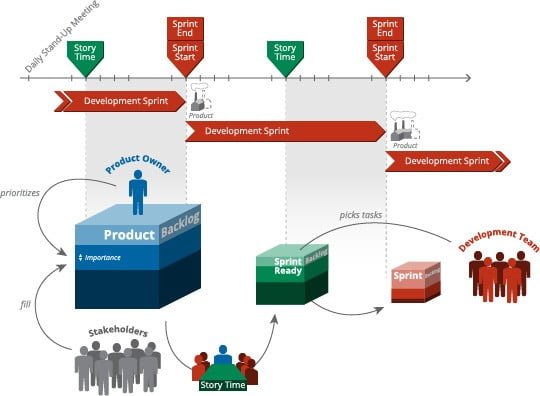
Agile Methodology, Customer Experience, Nearshore, Product Development
Common Myths & Misconceptions for Distributed Agile Teams in Software Development
Throughout this series, we have explored some of the best practices for agile-scrum teams, but in the light of distributed team situations. Scio provides software development teams – working from our development center in Morelia – for projects throughout North America. Our practices, methodologies, and culture are tuned to distributed team situations in a nearshore deployment. We discuss the realities of outsourcing and distributed teams with our prospects and clients on a regular basis. As we wrap up this series, let’s discuss some of the common myths and misconceptions that we hear about frequently.
There is no additional overhead for projects using distributed teams for agile-scrum projects.
Reality: Shared vision, communication, strong procedures, and planning are part of the required overhead for working smart in a distributed team environment. But, the truth is – these same elements should be part of any software development project to ensure success. While a distributed environment requires more rigor and attention to details, all projects benefit from addressing these issues.
More specification must be done at the start of a distributed team project
Reality: Increasing the upfront development of specifications for an agile-scrum project creates a false sense of security and understanding. When something needs to change, there will be latent resistance. There is an increased focus for the full team on understanding where the team(s) are and assuring knowledge is shared – but that should be a normal part of communication in any situation.
Distributed teams cannot do agile and scrum
Reality: If teams are able to organize independently, are cross-functional, collaborative, etc. – there is an overhead in coordination between teams (scrum of scrums) but mitigation in the form of improved awareness of the state of tasks can keep it to a minimum. It is much better to spend resources on coordination than fixes because one team went off the track, wasting time and resources.
Distributed teams have lower quality, more redo’s
Reality: If teams are cross-functional, managing their own tasks and backlog, enabled to work directly with the product owners, have a full development environment using test-driven development, continuous integration and practice regular builds on the central repository for the project, a great number of problems can be avoided. Regular team-wide meetings for planning, pruning, technical issues are overhead, but they will lower impediments greatly if done with openness and trust.
In larger projects, it is better to work as one team than two or more smaller teams even if some members are not co-located with the majority of team members
Reality: The communication and planning overhead does not go down in one larger team in comparison to two or more smaller teams, it rises. Size matters – smaller, self-organizing teams are more efficient overall. Team members in a larger team have less push to be individually responsible and to participate actively in the project. They can easily «hide» in the larger team. In larger teams, the overhead for work review actually climbs, because of the number of people who have to be informed and communicated with. And if the «larger team» is composed of remote members without properly recognizing them as distributed teams or single outside team members – the adherence to standard methodology, processes and assurance procedures tends to drop dramatically. They are literally «out of sight, out of mind.»
There are a lot more things that could be said, but the bottom line is – best practices matter in all agile-scrum projects. Agile is not a license to operate without structure – quite the opposite. It depends on individual responsibility, communication, and adherence to the processes and methodologies adopted by the project team. Agile is adaptive. It will scale along with scrum to situations with distributed teams. Teams that adopt the practices and procedures necessary to be successful in distributed situations as a part of their regular work patterns will have better results in all situations.
We hope this series has been useful and informative for you – helping you to understand what is «behind the curtain» in successful projects and some of the lessons we have learned in the field. If you have a project that you believe could benefit from a team that understands how to leverage agile and scrum in a nearshore implementation, don’t hesitate to contact us.

Agile Methodology, Customer Experience, Nearshore, Project Management
Organizational & Team Best Practices
In the previous article in this series, we started exploring the general organizational and team best practices for agile-scrum projects. In this article, we’re going to finish up a few basic issues and then move into points for distributed teams specifically.
As we have said, the main issue to be considered for software development with agile-scrum teams is communication. If communication is in any way blocked or stifled by cultural or organizational constraints, the team and the project will suffer. In a very real way, knowing how far along the work is on a given user story is part of that communication. We discussed building the technical elements of a system for test-driven development and continuous integration for projects, but there is an organizational element too. Team members must feel these tools are a part of their obligation to their team. They must use them religiously and fully to ensure the tools are doing the job of maintaining code and the development process for all team members. Here a few simple rules to live by:
- All development team members should check work into the common code base as frequently as possible.
- Automated, continuous builds should be run hourly with full logs turned on.
- Each individual team member must exchange a clean build by the end of their shift. Avoid situations where an individual is allowed to push multiple builds outside team core hours that could take planned work or tasks off course.
- If a specific development issue is to be addressed outside of core hours by developers, ensure the scope, limitations, and boundaries are clearly negotiated with everyone and adhered to.
Distributed Team Best Practices
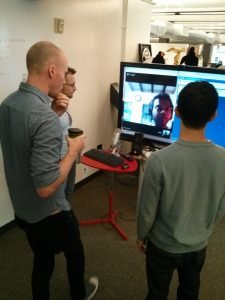
When a software development project is based on distributed teams, some specific organizational practices need to be considered. It isn’t enough to just set up groups in a couple of places, and expect everything to work like it did when you were all sitting in the same big room and able to just turn around and see your teammate.
The first point to consider is how each distributed team in the project will work. One common practice is to put all the QA (as an example) in one team and to have another team be just developers. The problem is – when locations are role-based, they tend to lose overall team collaboration and become an island to themselves. The tendency in this situation is to move to an «us against them» mentality. To avoid this, set up fully cross-functional teams that have their own user stories and backlog. It promotes the team and individual responsibility and gives them a clear role in the project as a whole.
With that in mind, there are a few additional points to consider:
- Use feature-based, rather than component or layer-based teams because it ensures teams continue to have a feeling of being integrated with other teams with shared vision and knowledge. It also allows them to be more flexible if the project changes. They can take on a different backlog because they understand where the project is going.
 Distribute work evenly – don’t allow one team to sit fallow while another catches up. This, of course, implies that regular discussions of workload (a scrum of scrums), dependencies, and assumptions is critical to the balance on the project as a whole.
Distribute work evenly – don’t allow one team to sit fallow while another catches up. This, of course, implies that regular discussions of workload (a scrum of scrums), dependencies, and assumptions is critical to the balance on the project as a whole.- When a team has a local «proxy» for the client-side product owner, it is critical that that proxy role has daily contact and communication with the core product owner to assure they can make decisions quickly and with the assurance they are in sync with the current vision.
- Each team must feel enabled to clarify issues directly with the client side (they have their own user stories – remember…) and not be tied to a chain of notification. Invariably, notification chains shorten messages, misunderstand the context, and create communication loops that just slow down clarification and decisions.
- Teams must have daily points of contact between them (scrum of scrums again) to discuss progress, dependencies, impediments, etc. and assure product owners are not being quarried about the same issues multiple times.
One Team Member «Outside»
There are times when it is necessary to have one lone team member outside the main development group or even a couple of individuals remotely located by themselves. This is not an unusual situation, but it is one that takes care to handle properly. All the work you do to assure a cohesive, collaborative team can be lost when one remote member is not paying their role and participating in the process properly.
In basic terms, all the distributed team and organizational best practices apply except:
- Single development team members cannot be a stand-alone unit in the same way a minimal team can – so they need to be formally paired with other team members in a way that assures they will remain «in the loop» throughout the project. To make this work, consider pair programming (especially early in the project) and pairing with a specific QA.
- Avoid situations where single team members are outside of the team core hours more by more than one or two hours. Longer isolation will simply assure they will not integrate easily with the rest of the team – they will remain the lone wolf on the outside you have to watch constantly to assure they don’t go off course.
- «Standard practices» (development environment, burndown chart, shared repositories, active participation in meetings, communication systems, etc. become critical resources to assure the remote team member feels they are a fully integrated and vital part of the project. All aspects of processes must be proven, clearly documented and relatively easy to setup and use.
- If the remote team member is new to your procedures and processes, have a standard initiation program as a part of the project initiation or before. The program should include not just the setup, practices and methodologies necessary to understand the way the team will operate. It should also include the reasoning and expectations they as a team member will operate under.
The single team member working remotely deserves some special consideration. They must feel they are part of the organization and able to be productive in their environment. For that reason, it is important to consider if they are working from their home, what kind of set up they have. Do they have good networking? Do they have a regular work area with good ventilation, light, and isolation from distractions? A worker at home, with the TV blaring in the other room or perhaps a baby that requires attention on a regular basis is going to find it very difficult to be as productive as their teammates. What can you do to assure they are not at a disadvantage? Consider issues in the same way you would any impediment in agile development – what can you do to move the impediment out of their way?
The Take-Away
In the end, it should be easy to see that that making an agile-scrum project successful with distributed teams is nothing more than doubling down on the best practices that are an integral part of agile. If they were important in a team in a single location, they are doubly important in a distributed team and have even more impact on project outcomes. Does a distributed team model immediately burden a project with additional overhead? Well, we will discuss this aspect more in the last article in this series, but the simple answer is no. If you have been using best practices for agile-scrum projects religiously – a project with distributed teams just requires a little more focus and diligence. If you were not as judicious as you should be about your practices, then yes, there will be overhead because your risk of failure will be much higher for distributed teams until you get your practices in line.
In our last article in this series, we will explore common myths that crop up whenever anyone proposes any level of distributed teams in software development. Remember, as a nearshore software development provider, these are objections we discuss with potential clients regularly. So join us – won’t you?
If you jumped into the middle of this series, you can go back to the start here.
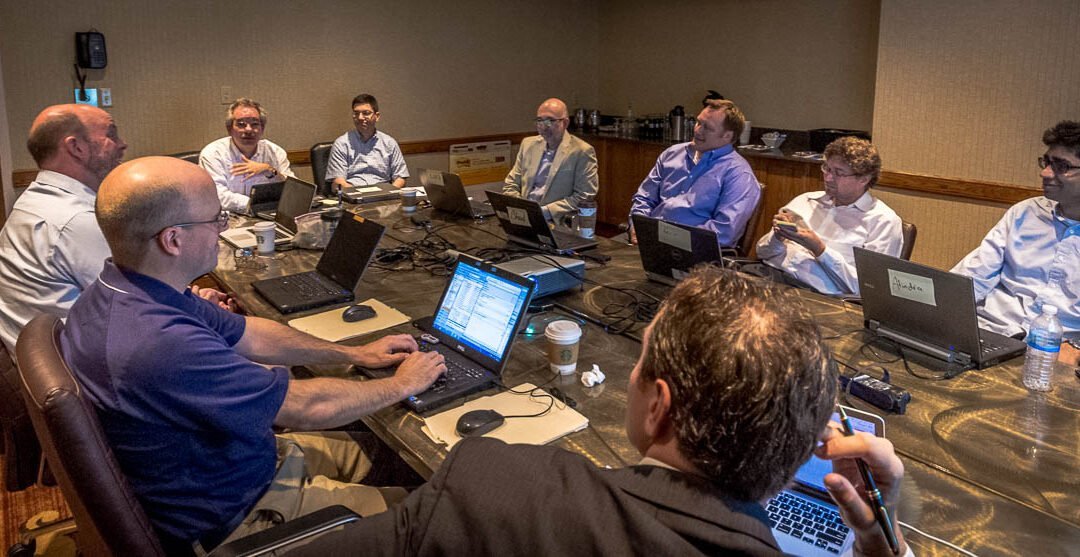
Agile Methodology, Customer Experience, Nearshore, Product Development, Project Management
Organizational and Team Best Practices
While it might seem that adopting the agile-scrum framework to distributed teams is all about the right tools (especially if you read marketing materials from tool makers), in general, it is more about how you organize your teams and processes than anything else. For that reason, we decided to break this part of the discussion into two sections. Our assumption is you are only going to read so much during your breaks between meetings, on your smartphone….
Project Initiation
 There are all sorts of reasons that a «kick-off» meeting is critical for project success, in fact, we’ve already talked about a few in the earlier posts from this series. But in this part of the series, we’re focusing on the organizational elements of a successful agile-scrum software development team.
There are all sorts of reasons that a «kick-off» meeting is critical for project success, in fact, we’ve already talked about a few in the earlier posts from this series. But in this part of the series, we’re focusing on the organizational elements of a successful agile-scrum software development team.
One of the areas that are especially important is the cohesion and understanding between the individual members of the team. If it is not taken care of the upfront, it can take a long time to build. If you are not aware of the teaming model developed by Bruce Tuckman, this is a good time to start considering it. In short, Mr. Tuckman found that teams follow a regular pattern of «storming, norming and performing» during their lifecycle. If you can shorten this cycle and get too strong performance sooner, you are better off. We have found that kickoffs that include games, team-building, and participative events go a long way to achieving this goal. In fact, for longer projects, planning similar events around specific milestones prevents teams from going back through the cycle later in the process.
There are many guides available for these activities, but regardless of which ones you find useful, the actual activities are not something you can simply jump into and do from a book. It takes practice and experience to successfully integrate team activities into project initiation so the sooner you start using them the better. We have found teaming model to be an excellent resource, but again, it requires some hands-on experience to use successfully.
What do you need to do to assure success for project initiation meetings?
- Include as many team members as possible in a single location, even if some must travel greater distances. The time and expense will pay off handsomely in the end.
- If some team members or teams cannot attend, arrange parallel events that the teams can report on or share in an online conference format (voice, video, photos, etc.).
- Sync your agile – scrum processes, artifacts, and ceremonies across teams and participants with actual sessions during the joint event. Execute sprints if possible (use Sprint 0 as a base). Set expectations with everyone that the processes will be standardized and adhered to across the entire team.
- Establish a shared product vision with presentations, question/answer sessions, product games, etc.
- Agree on core project hours for the entire team (including product owners, proxies, etc.) and communication standards. Core hours should overlap considering the time zones involved. Ensure everyone commits to core hours and provides proxies if they cannot be reached.
- Agree to set regular meetings during core hours even if not everyone expects to be in the meetings. This assures if questions come up during the meetings, they can be quickly answered.
- Agree on timing for sprint planning, retrospectives, and other planning activities. The more standardized the timing for these meetings, the more likely they will be to be integrated into individual routines.
- Learn and respect cultural viewpoints across the team, festivals, language preferences. Plan to share status around holidays, common activities, etc.
- Encourage an atmosphere of fun, respect, and collaboration.
This is a lot to accomplish in any timeframe, much less a day or a few hours. Project kickoffs must be carefully planned and managed. They could and often should take more than a day. We’ve had initial meetings, including initial work, take as long as a week. Once you have dealt with them to and from aspects of the travel, the rest is relatively inexpensive – so don’t push to shorten the time more than necessary.
Best Practices for All Scenarios

Planning component breakdown during the kickoff.
We’ve said that part of making agile-scrum for distributed teams successful is including many of the necessary best practices in all projects, not just the ones with distributed members. These best practices are critical for distributed teams, but also just good practice in any software development project. Your distributed teams will «catch on» quicker if these are part of your regular practice and adapt to new situations better.
- Participation by every individual in the team in meetings is always important. That said, it isn’t natural for everyone. Team members must be positively coached to engage in active, personal participation. Avoiding situations where one person becomes the de facto spokesman for the team helps to ensure team members don’t sit back and not contribute. Trust is an important element in participation. Team members must feel comfortable questioning ideas and playing devil’s advocate when necessary to draw out concepts and beliefs. Each team member must feel enabled to speak directly with the client/project team to avoid forming communication chains that will inevitably muddle and shorten their message.
- Plan frequent live demos and retrospectives with time for questions and clarifications. Communication in these meetings should not be more tightly time-bound than necessary, but when long conversations do surface, don’t be shy about moving them to a parking lot to be addressed in a specific meeting meant to resolve that issue with the right people involved.
- Scrum masters should be careful to practice servant-leadership roles. They need to concentrate on removing impediments so tasks can move forward rather than prescribing how tasks should be done.
- Pre-plan a larger window of future sprints on a weekly basis (depends on the length of sprints) specifically to expose interdependencies between teams, roles, etc. and groom backlogs with the team as a whole.
- Lean to short sprints rather than long and synchronize/prioritize between teams regularly. Avoid situations where a team could go too far down a path before syncing with others.
- Have irregular, casual «brown-bag» sessions to discuss technical alignment, decisions and common ground among members and teams.
- Find ways to rotate team members. Rotation can be between locations, roles, among teams, etc. Don’t allow individuals to become insular units by themselves or with specific team members. Accomplishing this goal can be challenging, but it is especially important in longer projects. Rotation should not be «one way» (always to the client site for instance) and where it isn’t possible, consider remote pairing too as an alternative.
Granted, these points are not easy to accomplish. They take planning and practice to get right – but the aim is to ensure a successful project and enough cannot be said about how much of success is preparation. The next installment in this series will continue to explore organizational and team issues, there is a lot to cover. We will also cover issues related to specific scenarios that we have found take a slightly different approach. I hope you will stay with us to see how important it is to understand software development projects in an agile-scrum environment and learn more about what is needed to extend it to distributed teams.
If you are coming in the middle and want to jump back to the start of the series, you can start here. Or if you are looking for a software development partner and want to contact us, just click here and leave us a message and we will be contacting you ASAP.
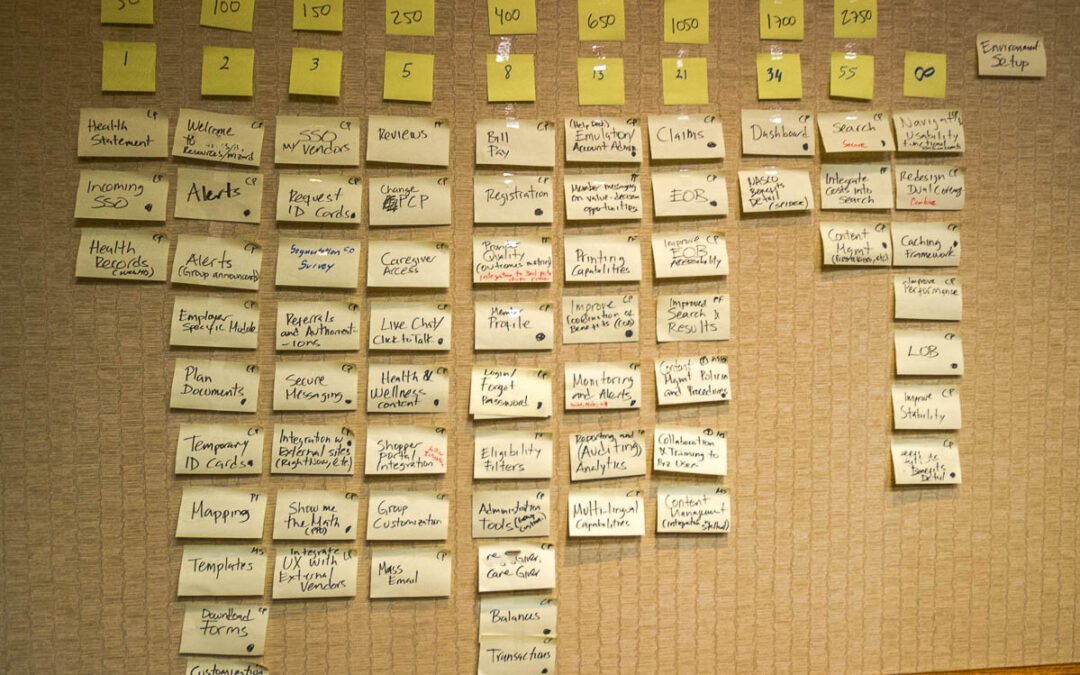
Agile Methodology, Project Management
Our thoughts on this subject come from practical experience. Companies who come to Scio with their projects often come with a multi-megabyte PDF, UML diagrams, and a list of specifications. “Give us a firm, fixed price for getting this project done by June 2nd at 2pm Eastern,” they say.
Their basic idea is:
- Software projects have a much less than enviable record of finishing over budget and way over the estimated completion date – we’ll set those so they can’t creep.
- Software outsourcing is risky so we’ll limit our risk by agreeing to a cost and timeframe we can live with and possibly tag onto some event. “Shoot for the June trade show so we have a shiny new product to sell,” Marketing begs.
- We don’t have the resources to do the project in house, but we don’t trust any outsourcing group – so we’ll rope them in with a fixed fee and time and put all the risk on them.
- We know perfectly well what our product needs to be. If we don’t nail this down, we won’t get what we need for the price we can afford.
The result of this thinking generally speaking is:
Flaming Disaster!
Why? Their basic instinct wasn’t wrong. Software projects do fail to meet their targets with astonishing regularity. They were just trying to limit their exposure. What is happening?
There are five intrinsically linked factors in estimating software product development projects:
- The Total Elapsed Time expected to produce the specified product.
- The Effort required to produce the product.
- The Cost the client expects to expend.
- The Resources required for the project – their skills and availability.
- The Specifications for the product; the features, functionality and user experience.
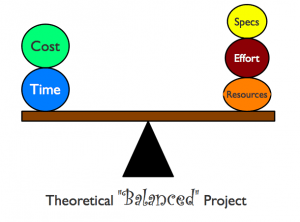 In general terms, what clients are trying to do is set a “target.” In project management, the general assumption is you can set any one of the five factors as a target for a project, but when you do, you need to let the other four float to where they need to go to reach the target. So if you set cost, you need to vary time, specifications, effort and/or resources to reach a mix that will achieve the project goals within the target cost.
In general terms, what clients are trying to do is set a “target.” In project management, the general assumption is you can set any one of the five factors as a target for a project, but when you do, you need to let the other four float to where they need to go to reach the target. So if you set cost, you need to vary time, specifications, effort and/or resources to reach a mix that will achieve the project goals within the target cost.
Instead, clients set two or more factors in an attempt to “hold the line” on all the other factors. They spent a lot of time on those specifications. They need them all!
 But in fact, setting more than one factor as fixed creates an almost impossible tension among the remaining factors that almost assures the project will fail to meet its goals. There are no levers left to control the project! It starts out with the best of intentions, but with two or more factors fixed, any change in circumstances during the project creates an imbalance that cannot be corrected with the remaining factors.
But in fact, setting more than one factor as fixed creates an almost impossible tension among the remaining factors that almost assures the project will fail to meet its goals. There are no levers left to control the project! It starts out with the best of intentions, but with two or more factors fixed, any change in circumstances during the project creates an imbalance that cannot be corrected with the remaining factors.
Why does this happen? Stepping away from our example of setting time and cost as the fixed factors – think about each of the factors individually and the impact they have on the project:
Time
The elapsed project time from start to finish is always different than the total effort applied. Time is measured by a calendar start to finish. Conversely, the effort is the sum of all the time expended on a project by the assigned resources. Total time is never equal to the total effort unless only one resource is assigned, full time.
Software development projects rarely finish on time. Unplanned specification changes, unexpected risks, and resource changes always build up over time and eventually result in a project that is both over budget and beyond the allocated time.
Time to completion can only be estimated and controlled well over short periods. As the time period considered in an estimate increases, the accuracy begins to degrade because of variations in the expected effort, the depth and complexity of the specifications involved, the skills and availability of the resources required and the limitations an assumed total cost puts on the project.
It should also be understood that time to project completion is rarely scoped as a direct result of estimating the effort required. More often, “artificial completion dates” evolve from a point in a product marketing plan, the current product position, and/or customer demands. When this happens, there is usually some consideration of project scope but is rarely enough to address the situation that arises from not first doing a straight-forward evaluation of the effort required to complete the specified product.
Effort
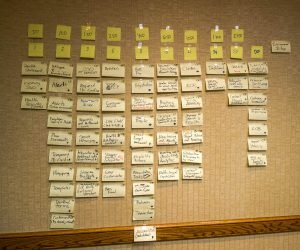
Scio Consulting
The accurate estimation of effort is key to successful software project costing and setting a realistic expected time to completion. In practice however, the amount of effort required to actually produce each bit of application functionality always varies from estimates. The more detailed and contingency bound the estimate becomes, the more likely it is to be wrong. Because of this, past experience and general effort assumptions are used across a project estimation, in the belief that in the final outcome everything will average out. Of course, the reverse is also true; averages can never address all risks in an individual project. So, while averages are a practical approach to project estimation, they cannot yield a project quote that can be fixed to a specific figure without risk.
In this situation, risk buffers for variations in specifications and resources are recommended for effort estimation, especially in Agile development methodologies where development iterations are “timeboxed.” Timeboxing iterations means variations in the effort will generally cause functionality to be pushed ahead to the next iteration and a “snowball effect” can be produced where the amount of effort required for each iteration increases incrementally beyond estimates over time. If buffers were used, more projects would reach their estimates, but in the drive to reach a more competitive price, they are rarely employed when using assumed effort to arrive at a fixed cost. This results in a very narrow margin for error in effort estimation.
In addition, the amount of time required to reach project completion is not directly related to the number of resources available concurrently. Determining effort depends on an experienced assessment of an efficient team size for the project and the methodologies used. Increasing the number of resources and concurrent tasks beyond a certain point increases coordination and communication overhead exponentially. Increased team size tends to increase errors, oversight, and testing cycles without a cost-effective increase in total output.
Estimates of effort required tend to be assessed from a straightforward analysis of specifications. During projects, the actual effort required frequently increases beyond estimates because of “fixes” required to bridge the gap between specifications and the product as realized in development. In addition, the elapsed time required for QA by the client team is often underestimated and can result in either idling development or moving ahead with incorrect assumptions and subsequent rework.
Cost
Software development projects almost never finish under their expected cost from the point of view of clients. A few finishes at the client’s target cost, but generally only at the expense of other project factors. As a result, when projects do cost what was originally expected, the product is often a failure from an end-user point of view.
For clients, the target project cost is generally a function of:
- Expected product price and the desired return on investment that could be produced by an estimated number of paying customers in a reasonable period of time. In other words, a string of dependencies that may have little basis in the final analysis.
- Available funds and cash flow limitations.
- Experience with “similar projects” – However, only rarely do estimates based this way actually works out to be similar in the effort required.
Target cost is never or only rarely based on:
- The steps and effort actually required scope and develop a product that is a successful market fit.
- Small, incremental steps that can be estimated with a reasonable chance of success.
Specifications
Specifications are almost always assumed to be a known and set factor in fixed cost projects. They are used as the basis for effort estimation and effort estimation ultimately determines the quoted cost. Clients generally have a basic expectation that their specifications do not need to be varied from substantially to produce the desired product at the specified cost. Clients often expend great amounts of time producing specifications for bid to assure they will be complete and assumed to be fixed. But in fact, not assuming specifications will need to be varied as over the course of a project to meet fixed cost results in a continuous tension between the effort required, the scope remaining and the time remaining on the project clock.
Most fixed cost projects have intentionally limited options to change scope. Instead, limiting scope change by not providing workable options increases the risk the project will not reach the desired goals when the actual product is assessed by end-users.
Software development requirements can never be complete enough or communicated well enough to ensure understanding and success. Errors in interpretation, over-broad and over-complex specifications result in many “fixes” that are not related to actual code errors by the development team. These fixes are actually elaborations or “clarifications” of project specifications, but in most projects, they are assumed to be “bug fixes” in the process of development, testing and QA. In practice, this means the actual functionality works as specified but the implementation is not as desired by the client. Fixes of this type generally add to effort and resource allocations without the assumption they should impact specifications, time or cost.
Software development project requirements are by their nature improved by the discovery on the part of both the development team and the client team during analysis and development.
In the course of normal work, discovery exposes:
- More depth than expected (scope creep).
- Different aims and approaches from the client and end-user feedback or unexpected insight from seeing the product as it develops.
- Technical limitations or alternative approaches that change requirements, the effort and time required.
- In most software development projects, there are no assumptions or procedures to handle specification discovery and subsequent changes. This results in many variations from project estimates and is a significant factor in project overruns.
Resources
Resource management is a function of having the right skills available when needed for a specific task in a project. With limited resources and funds, this is a difficult task for software development companies.
Both internally and externally, software development companies have an ongoing need to balance new projects against support, maintenance, and enhancement of existing applications. Companies need to decide the level of investment they will put into new technology. Using time from existing work to move to new technology skills is a difficult and expensive proposition. Recruiting for internal resources is a long, expensive process that often fails to yield dependable, trained resources in the long run.
These factors are the leading reasons clients consider outsourcing. But they are also a factor in outsourced projects themselves because, at some level, the client team becomes involved directly with the outsourced team and the results of team resource management. The management of new software development projects is difficult by itself. Because of the time and risks involved in recruiting resources with appropriate skills and knowledge, client project/product managers often don’t have a good understanding of the technology and limitations in the project they are managing.
In this situation, outsourcing software development often leads to a confrontational relationship where the client team feels they have lost control and don’t understand the choices the outsourced development team has made or what effort is being applied to produce deliverables. They don’t understand that the estimation for time to completion was figured against assumed effort but the accuracy of that assumption varies according to specification clarity, resource skills, and availability.
In Summary
Variations in the five factors during a software development project leads to:
- Defensive reactions to clarifications and changes between the client and the development team.
- Situations, where the actual effort in the given time varied depending on specification accuracy and resource skills and availability, lead to confrontations. When the time to completion is figured for a fixed cost, it is generally figured against the assumed effort. Without assumptions for what controls are available to deal with variation, the confrontation continues to simmer throughout the life of the project.
- Lost opportunities for a partnership-like relationship of shared risk and reward.
The solution could be as simple as not setting more than one factor as fixed, but in practice that is hard to do for many projects. What is really needed is a consultive framework for communication and decision making that is informed by real-time reporting during the project and the collaborative resolution of issues to reach the client’s goals. It’s easy to say, but it takes understanding, planning, and agreement to accomplish.
We’re constantly working on this paradigm every day – it’s challenging and rewarding. What’s your experience? How do you hold the line? What controls do you have realistically? Have you recognized the five factors in your project estimation process formally? I’d love to hear your thoughts…
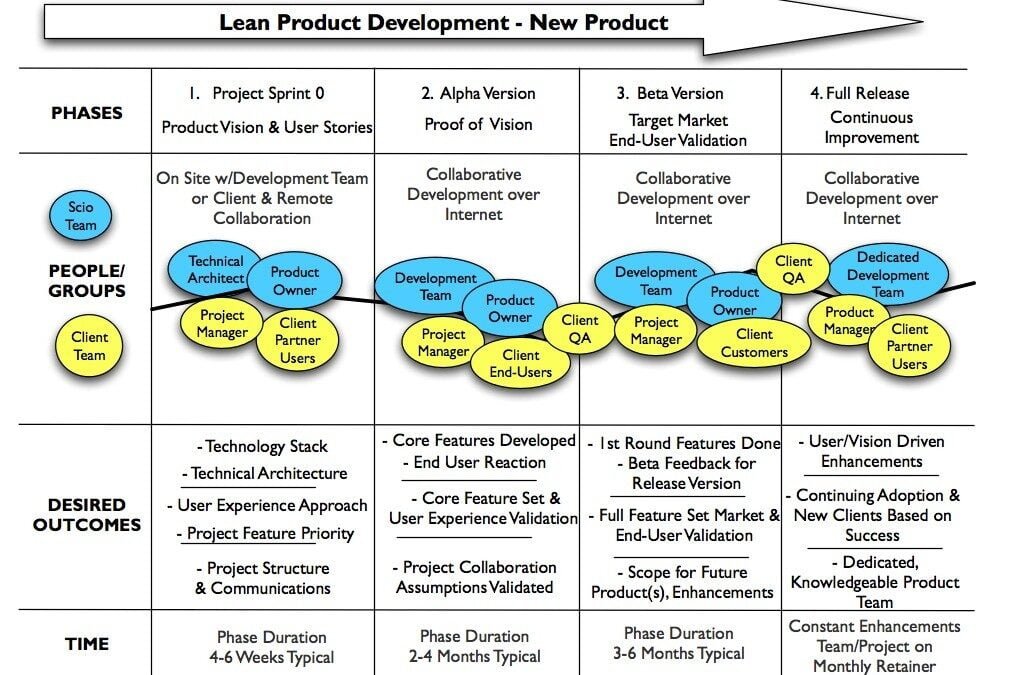
Agile Methodology, Featured, Product Development, Project Management
When you develop software products in a repeatable, production fashion, you have to step back occasionally and take the long view so you can properly discuss the process with clients. We’ve been involved in that exercise recently and I thought it might be useful to share the what and why of our approach to software product development for online products.
First, there is one basic idea that informs all of this:
We define the “Big Bang” Market Release model as:
- A black-box project where significant work is done up front to bring together requirements documents which detail the features and functionality in great depth for a software development project that typically lasts from 12 months to two years.
- The time expended on requirements development is expected to provide prospective developers with a very specific vision of the product that can be put out for bid, will put a box around scope, cost and time, and will last throughout the project.
- On release, the exhaustive feature list is expected to drive market adoption and leapfrog existing competitors.
This is different from the closed box, rapid development method that is sometimes also called «Big Bang.» In that in that case, no time is expended on specifications or plans with users or clients. In Big Bang Development, the development team comes up with all the features and implementation based on a rudimentary concept, goes away, and hopefully comes back with something useful. To say we are not believers in this software development methodology is something of an understatement. It is high risk and low reward because the client does not fully understand what they want or what they will get.
In contrast, the concept of the Big Bang Market Release comes from the simple idea that a product can create a market simply by existing in a complete vision that will bring out buyers for a concept that may have never existed before. Specifying software product development in this situation is tricky. Apple has been the leading success story that is cited when this concept is brought forward. Companies that want to create markets, but cannot do the entire product development in house, strongly understand their need to reduce the risk of failure to realize their vision when the application is ready for release. And often, because of the technology and innovation involved, they know they cannot provide the in-depth technical oversight needed during the project. So rather than allow interpretation or adaptation during development, extreme care is exercised to write very specific requirements and lock them down.
Regardless of those worthy aims, these projects continue to fail because:
- Controlling scope over the life of a project becomes increasingly difficult as the project complexity and time span increase. Prediction accuracy degrades geometrically over time – eventually yielding a project plan that can only be relied on at a high level.
- Technology continues to respond to Moore’s Law. The longer the requirement development takes, the longer the project goes on, the less likely it is to meet the expectations of the market on delivery. User expectations have moved on, informed by alternatives they have tried in the interim. In addition, the technology assumptions at the beginning of a long, complex project don’t always work out when development actually takes on the complexity of feature integration. So the choice of a tool, framework, or library may seem like it solves a lot of problems at first, but in practice may turn out to be a black hole into which resource time disappears.
- No matter how detailed requirements are – they are limited by two things: point of view (the classic story of the blind men and the elephant is the common point of reference) and actual feedback from end users of the resulting application. No matter how carefully feedback from end users is brought together for requirements, it is only as good as their vision of the final product. As we and others have said many times – if you asked people at the start of the 1900′s what they wanted for personal transportation – the requirements would only lead to better horses. It is rare for requirements to both anticipate user needs correctly and the complexity of delivering them in a particular way. The risk in requirements actually increases the more detailed they become – especially in cases where they are so specific they cannot respond to end-user feedback early in the development process.
So – what is the alternative?
Consider “Lean Product Development» as a base. We have developed an adaption of the lean concept to software product development that we have leveraged over several projects and across several industries :
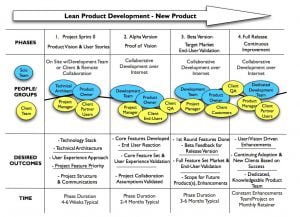
Lean Software Product Development
The phases and their aims break down this way:
- Sprint 0 – During this phase, requirements are verified, technology choices are made in detail (architecture, stack), user stories are built (we use agile development techniques – user stories are roughly equivalent to use cases), and the user experience (more than just interface, how a user will use the product) approach is developed to set interaction standards. The outcome of this phase is a set of technical specifications, personalities (roles to a degree), and prioritized user stories with effort estimates for each story.
- Alpha Version – During this phase, the underlying framework is built and core functionality is developed for key end-users. The point of this phase is to verify the product vision with the key audience of the application – the end users who perform the most critical tasks and use the application most. This means the alpha version needs to be actually be tried by the core end-users. This usually requires client partners – which in the case of a new vendor requires getting out into the market and bringing in some early adopters. The outcome is to lower risk. The cost at this point is low, compared to the whole project, so changes can still be absorbed without loss of large portions of developed code and sunk costs. Also, at this point, the approach of the development team in carrying out the vision of their client can be verified early – so that adjustments can be made and trust between the client and the development team can grow. This approach follows the sage advice articulated by Steve Blank – the point of early user validation is to get «out of the building» and get in front your audience early so they can inform development before costly mistakes are made.
- Beta Version – This phase produces the first cut of the market version of a product. It is important to understand that the scope of this version is intentionally limited to just what is necessary to deliver value to end users. In other words – deliver just what they will use and PAY FOR. This is a critical assessment that is informed by both the vision of the subject experts and the feedback from the Alpha Version. The problem is, however, no matter how good the vision and feedback are, there will be additional feedback when the product hits the many different contexts of actual target end-users in the market. The release of the beta version also provides the “kick-off” of internal operations for the provider – and in the case of most products – support, sales, and marketing. The lessons learned from beta release then inform the next phase so that beta adopters are rewarded (and retained) and operations deliver the message and services needed to drive new customers and user adoption. Because of the incremental nature of agile-based release cycles, the actual point when sales are made during this phase varies a lot between products – but development doesn’t stop. What changes is that development is now more directly informed as new customers come on and participate in the beta. Some companies test pricing and marketing more aggressively at this point than others – but the general recommendation is to establish pricing early and test it against the perceived value from users. The outcome isn’t expected to be an adjustment to pricing directly but rather an adjustment of features or packaging to better align with perceived value.
- Market Release – This phase marks the release of the full market product and the beginning of “normal” product enhancements to continue to grow functionality in alignment with user feedback. We sometimes add a phase for development up to market release itself that is separate from beta – but for general purposes – development has now slipped into an enhancement mode, rather than full out development unless there is a significant difference from what is planned for release to beta customers and the general market. The outcome of this phase is a product informed by target user feedback, tested business operations and a change of focus from getting the product “out the door” to getting customers and continuing to enhance features and functionality. It is not an end point – it is just the start of the natural evolution and “pull” of a “consumerized” online product.
The outcomes of this process are:
- Early release and feedback from the people who count – the actual paying users in the field.
- Early validation that both the vision and the requirements are resulting in a product that delivers value and will meet market expectations.
- Lower up front risk and lower time to profit. Waiting over a year to put a product in the market with real users is a recipe for disaster. Getting into the market, proving operational assumptions and kick-starting cash flow as soon as practical is key to success. The sooner you get into the market, the more time you have to adjust to reality before your startup cash pile is burned up.
- Simple – a higher chance of success measured by what counts – adoption, cash flow from customers and retention of users.
However, some of our customers face a little more difficult situation – they have an existing product in the field that started life as a traditional premise-based product and is now being pulled to adopt a more dynamic, online model. That brings an additional set of issues:
- If the development cycle is long, existing clients may jump ship before the full online version is available.
Support and maintenance of the existing product can overwhelm the key members of the product team that need to be available to shape the new product. Finding a point when transition can begin in an orderly fashion, without cannibalizing existing sales is critical.
- The new direction provides an opportunity to develop new markets, adopt new pricing levels and transition to a pull-driven feature model (rather than the push of traditional product releases) but timing is key. For a complex product meeting the needs of the top of a vertical market this becomes a huge exercise and is frankly very difficult to break down into manageable pieces.
To deal with that we have a general model that takes the new product template above and turns it into a phased development of a suite of products. In the diagram below – you can think of each of the blue boxes as a modified run of the our typical product develop cycle:
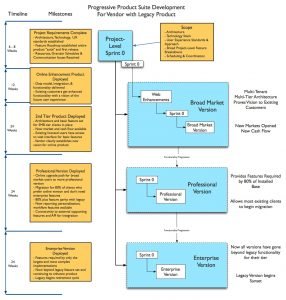
Progressive development for a suite of online software products
The major steps in this are:
- Sprint 0 – A holistic project-level requirements, technical specifications and feature breakdown that sets the stage for the entire project – but doesn’t lock assumptions down. The point of this entire project is as before, get products out early, get feedback and cash flow as soon as practical. This also includes a more detailed look at the first product in the suite.
- Web Enhancements – This part of the first product release is optional, but worth considering as a way to ensure existing customers stay onboard for the long run and can see the long vision early – so they will become key in feedback as the product progresses through the lifecycle. What form this product takes varies, but the idea is to enhance the existing product with features that suit the Internet environment particularly well and extend it in ways not possible before because of technology or restrictions inherent in the on-premise version.
- Broad Market Version – To allow early feedback and to get into the market as soon as possible, the first product needs to be a focused subset of the expertise expressed in the legacy product that addressed the top of the market previously. Generally, this means providing a set of features that will provide value for the 2nd and perhaps 3rd tier of the market. Again, all the points of a typical product release as we first described need to happen in this release so the product is informed by actual end-users in the target market – which coincidentally is a new market for the vendor.
- Professional Version – Building on the same code base as the Broad Market Version, the professional version targets the features which will satisfy 70-80% of their installed base. This sets the stage for migration and broadens potential adoption by a group of customers who will pay significantly more for the value the product delivers. This also marks the point where legacy support and maintenance can begin to turn the corner and clearly move toward the new product.
- Enterprise Version – Again, on the same code base, enterprise functionality is added and now the entire “product suite” has reached levels of functionality never achieved in the legacy version. Users pick levels by feature packages within the suite – so if properly architected – there is a lot of variation in pricing and packaging possible to meet needs in different markets.
It should be said that the timeframes proposed here are generalizations and will vary, but – they are based on the assumption that development should focus on delivering features with value to end users. Everywhere else, the simple rule “less is more” should be followed with the leverage of services and frameworks wherever practical. The architecture needs to allow those services to be used as long as necessary, but to be replaced as growth provides the option to drive down the cost of service. It should also be said that features and customization in this approach come from choices of what is made available to roles in market packages and configuration – not separate versions.
Now, I’ll admit this is a big vision and a lot to absorb in any context – either as a startup or a software company with legacy products in the market. And – it is a big shift in how we have looked at software product development. It comes from our own experience of the issues we find repeatedly in the market. I can’t say it is an approach that every development group can provide successfully. It depends on making clear choices that will provide these outcomes and not waffling with half measures.
What do you think? Can you see your company going down this road? Can you see the benefits? Let me know…
Do you want to develop a lean software product? Contact us right now!

 This issue is a problem across outsourcing but of particular importance in offshore relationships. When problems are perceived during a project, they are most often traced back to an individual or team, not the processes or operational procedures in place that created the environment where the problem happened. Instead of examining the situation, organizational norms, processes and methods (and their implementations), we have a strong tendency to look for a scapegoat, a person that is at fault. This leads to a loss of trust within the team as a whole and enforcement of hierarchical control – exactly the opposite of what we need if we depend on a strong, agile team to function properly. Increased hierarchy means less direct communication with developers and conversely, less independent thought from people whose skills as «knowledge workers» makes them valuable. In an offshore situation, this can be fatal to project outcomes if there is not full-time, offshore and onshore coordination and management – which of course – raises costs and lowers productivity. And because once we have targeted an individual rather than other factors, we are very likely find ourselves repeating the same problems over and over, in slightly different configurations.
This issue is a problem across outsourcing but of particular importance in offshore relationships. When problems are perceived during a project, they are most often traced back to an individual or team, not the processes or operational procedures in place that created the environment where the problem happened. Instead of examining the situation, organizational norms, processes and methods (and their implementations), we have a strong tendency to look for a scapegoat, a person that is at fault. This leads to a loss of trust within the team as a whole and enforcement of hierarchical control – exactly the opposite of what we need if we depend on a strong, agile team to function properly. Increased hierarchy means less direct communication with developers and conversely, less independent thought from people whose skills as «knowledge workers» makes them valuable. In an offshore situation, this can be fatal to project outcomes if there is not full-time, offshore and onshore coordination and management – which of course – raises costs and lowers productivity. And because once we have targeted an individual rather than other factors, we are very likely find ourselves repeating the same problems over and over, in slightly different configurations.
 Language – Although English is certainly the language of business around the world, it isn’t everyone’s native language and although many people can read English, not everyone can write and discuss ideas verbally with the same proficiency. In addition, culture and local contexts are part of understanding each other, no matter what language is spoken. A common spoken word in one location may have no direct counterpart in another location. My «door jamb» is funny if you understand what you hear as «jam» only makes sense as a form of marmalade. If a member of your team has very little conversational experience in English, it is likely they just won’t speak in meetings because they are afraid they might say the wrong thing and they can’t follow the conversation completely. As these barriers rise, so do the work-arounds. A facilitator or go-between is added to «ensure clear communication» but in the process of clarifying they also over-simplify and leave out critical details. A translation point is added so each side doesn’t have to deal with complex issues in a language they are not familiar with but because the translator isn’t a technical or business expert, many nuances are lost in translation.
Language – Although English is certainly the language of business around the world, it isn’t everyone’s native language and although many people can read English, not everyone can write and discuss ideas verbally with the same proficiency. In addition, culture and local contexts are part of understanding each other, no matter what language is spoken. A common spoken word in one location may have no direct counterpart in another location. My «door jamb» is funny if you understand what you hear as «jam» only makes sense as a form of marmalade. If a member of your team has very little conversational experience in English, it is likely they just won’t speak in meetings because they are afraid they might say the wrong thing and they can’t follow the conversation completely. As these barriers rise, so do the work-arounds. A facilitator or go-between is added to «ensure clear communication» but in the process of clarifying they also over-simplify and leave out critical details. A translation point is added so each side doesn’t have to deal with complex issues in a language they are not familiar with but because the translator isn’t a technical or business expert, many nuances are lost in translation. Time Differences – In offshore situations, the working day time difference between teams can mean that there is no overlap or that there is only one or two hours in a day when some direct contact can be made. Even when accommodations are made, it is generally done by putting one or two people in the combined team at a disadvantage. If the product owner makes themselves the key point of contact, they will have to find time to accommodate the outsourced team and their local team members which can result in some very odd and frustrating hours. If a local technical manager and a distant technical manager are implemented (as is often the case), communication fidelity is lost because the production team and the product owner are not in direct communication most of the time. There are many variations of workarounds for time differences, but for software development projects, this can be a very significant issue and barrier to good project communication.
Time Differences – In offshore situations, the working day time difference between teams can mean that there is no overlap or that there is only one or two hours in a day when some direct contact can be made. Even when accommodations are made, it is generally done by putting one or two people in the combined team at a disadvantage. If the product owner makes themselves the key point of contact, they will have to find time to accommodate the outsourced team and their local team members which can result in some very odd and frustrating hours. If a local technical manager and a distant technical manager are implemented (as is often the case), communication fidelity is lost because the production team and the product owner are not in direct communication most of the time. There are many variations of workarounds for time differences, but for software development projects, this can be a very significant issue and barrier to good project communication.




 Distribute work evenly – don’t allow one team to sit fallow while another catches up. This, of course, implies that regular discussions of workload (a scrum of scrums), dependencies, and assumptions is critical to the balance on the project as a whole.
Distribute work evenly – don’t allow one team to sit fallow while another catches up. This, of course, implies that regular discussions of workload (a scrum of scrums), dependencies, and assumptions is critical to the balance on the project as a whole.
 There are all sorts of reasons that a «kick-off» meeting is critical for project success, in fact, we’ve already talked about a few in the earlier posts from this series. But in this part of the series, we’re focusing on the organizational elements of a successful agile-scrum software development team.
There are all sorts of reasons that a «kick-off» meeting is critical for project success, in fact, we’ve already talked about a few in the earlier posts from this series. But in this part of the series, we’re focusing on the organizational elements of a successful agile-scrum software development team.

 In general terms, what clients are trying to do is set a “target.” In project management, the general assumption is you can set any one of the five factors as a target for a project, but when you do, you need to let the other four float to where they need to go to reach the target. So if you set cost, you need to vary time, specifications, effort and/or resources to reach a mix that will achieve the project goals within the target cost.
In general terms, what clients are trying to do is set a “target.” In project management, the general assumption is you can set any one of the five factors as a target for a project, but when you do, you need to let the other four float to where they need to go to reach the target. So if you set cost, you need to vary time, specifications, effort and/or resources to reach a mix that will achieve the project goals within the target cost. But in fact, setting more than one factor as fixed creates an almost impossible tension among the remaining factors that almost assures the project will fail to meet its goals. There are no levers left to control the project! It starts out with the best of intentions, but with two or more factors fixed, any change in circumstances during the project creates an imbalance that cannot be corrected with the remaining factors.
But in fact, setting more than one factor as fixed creates an almost impossible tension among the remaining factors that almost assures the project will fail to meet its goals. There are no levers left to control the project! It starts out with the best of intentions, but with two or more factors fixed, any change in circumstances during the project creates an imbalance that cannot be corrected with the remaining factors.


